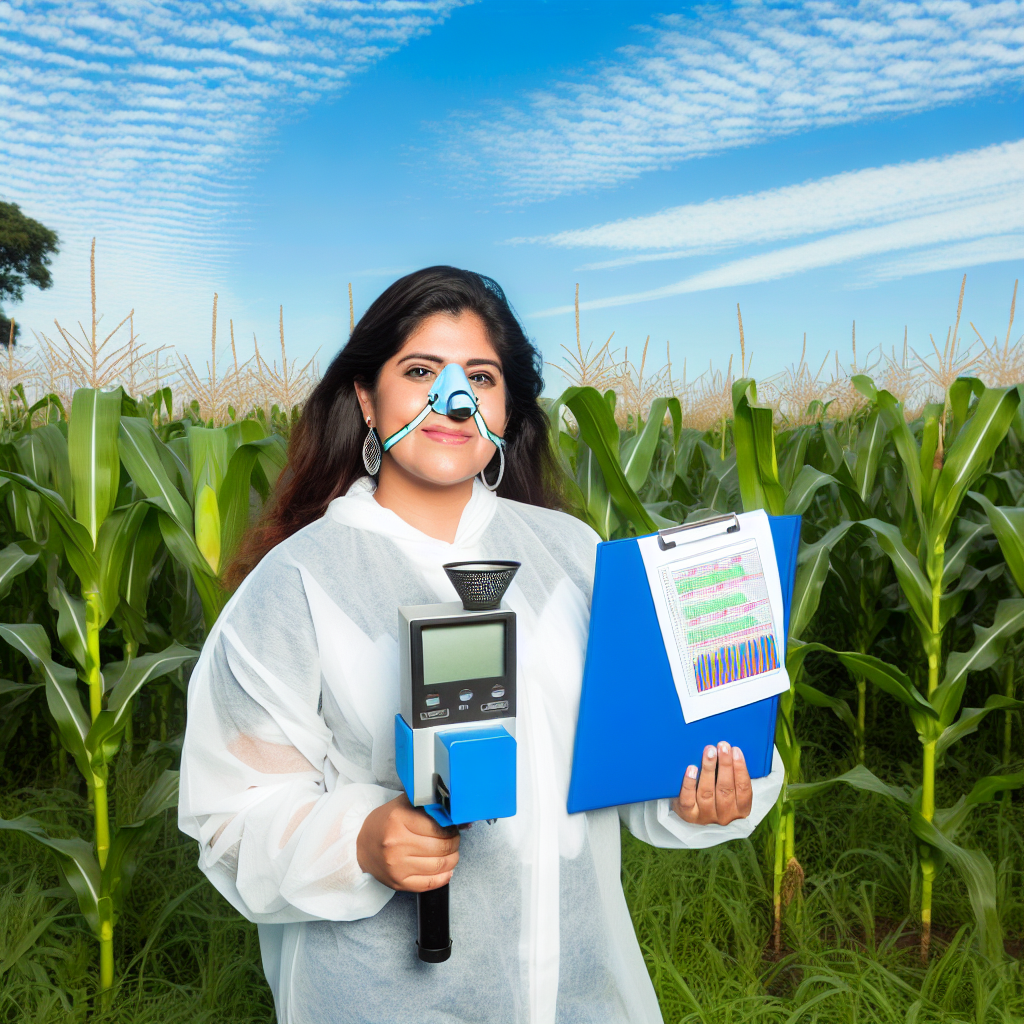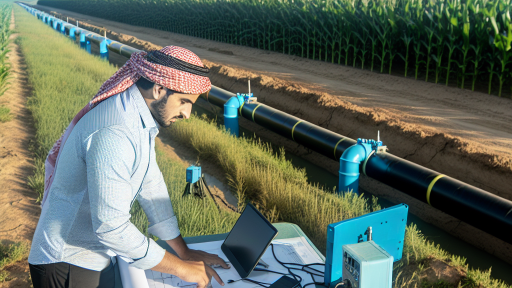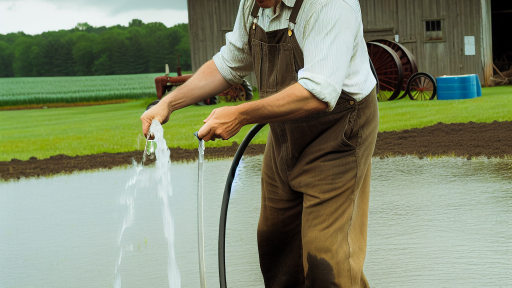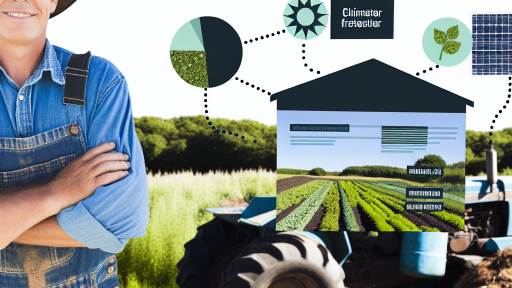Introduction to Greenhouse Gases in Agriculture
Greenhouse gases play a critical role in climate change.
Agriculture contributes significantly to these emissions.
Understanding this impact is vital for our planet’s health.
Types of Greenhouse Gases Released
Agricultural practices release various greenhouse gases.
Carbon dioxide (CO2) results from soil tillage.
Methane (CH4) emerges from livestock digestion and manure management.
Nitrous oxide (N2O) arises from the use of synthetic fertilizers.
Each gas has different effects on global warming.
Impact of Greenhouse Gases on the Environment
Increased greenhouse gas emissions lead to climate change.
This results in extreme weather conditions globally.
Crops face unpredictable growing seasons and productivity challenges.
Moreover, biodiversity suffers as ecosystems become destabilized.
Global Initiatives and Research
Various international agreements address greenhouse gas emissions.
The Paris Agreement aims to limit global warming to well below two degrees Celsius.
Research initiatives focus on sustainable agricultural practices.
Transform Your Agribusiness
Unlock your farm's potential with expert advice tailored to your needs. Get actionable steps that drive real results.
Get StartedInnovations in farming can mitigate greenhouse gas emissions.
Countries are exploring ways to implement new technologies.
Strategies for Reduction in Agriculture
Farmers can adopt practices to lower emissions significantly.
Examples include improved nutrient management techniques.
Crop rotation helps in enhancing soil health.
Conservation tillage reduces soil erosion and carbon loss.
Integrating livestock and cropping systems can optimize land use.
The Role of Smart Agriculture in Reducing Emissions
Understanding Smart Agriculture
Smart agriculture uses advanced technology for farming practices.
It integrates data analytics, IoT devices, and automation.
Consequently, it enhances productivity while reducing resource consumption.
Reducing Greenhouse Gas Emissions
Smart agriculture significantly lowers greenhouse gas emissions.
For instance, precision farming optimizes fertilizer use.
This approach minimizes excess application, reducing nitrous oxide emissions.
Enhancing Resource Efficiency
Smart farming improves water efficiency through targeted irrigation.
Technologies like drip irrigation reduce water wastage significantly.
Moreover, crop monitoring systems ensure that plants receive optimal care.
Promoting Sustainable Practices
Smart agriculture encourages the use of renewable energy sources.
Many farms utilize solar panels to power operations.
Thus, they reduce their reliance on fossil fuels and decrease emissions.
Implementing Climate-Smart Technologies
Investing in climate-smart technologies is crucial for modern agriculture.
Farmers can adopt practices such as cover cropping and reduced tillage.
These methods enhance soil health and carbon sequestration.
Collaboration and Knowledge Sharing
Collaboration among stakeholders fuels innovation in smart agriculture.
Farmers, researchers, and tech companies can share insights effectively.
Showcase Your Farming Business
Publish your professional farming services profile on our blog for a one-time fee of $200 and reach a dedicated audience of farmers and agribusiness owners.
Publish Your ProfileThis partnership drives the development of sustainable solutions.
Precision Farming Techniques to Optimize Resource Use
Utilizing Technology for Enhanced Monitoring
Precision farming leverages advanced technology to enhance crop monitoring.
Farmers can deploy drones to gather real-time data on crop health.
This data allows for timely interventions and informed decision-making.
Remote sensing also helps in assessing soil conditions effectively.
Hence, technology equips farmers to respond swiftly to changing conditions.
Implementing Soil Health Management
Soil health is critical for sustainable agriculture.
Farmers utilize cover crops to improve soil structure and fertility.
Crop rotation practices also enhance nutrient cycling in the soil.
Additionally, adopting minimal tillage reduces soil erosion significantly.
Overall, these practices contribute to optimized resource usage.
Optimizing Water Resource Management
Water conservation is vital in modern agriculture.
Farmers adopt drip irrigation to minimize water wastage.
This method allows targeted water delivery directly to the roots.
Utilizing rainfall harvesting systems can also supplement water supply.
Consequently, efficient water management boosts crop productivity sustainably.
Data-Driven Decision Making
Data analytics plays a key role in precision agriculture.
Farmers analyze historical data to predict future outcomes.
Using this information, they can allocate resources more effectively.
For instance, applying precision application technology reduces fertilizer use.
As a result, farmers enhance yields while minimizing environmental impact.
Enhancing Crop Yield Through Smart Practices
Implementing smart farming practices maximizes crop yield.
Farmers can use sensor technology to monitor moisture levels effectively.
Regular analysis of this data informs irrigation schedules accordingly.
This leads to healthier crops and improved overall yields.
Furthermore, integrating weather data assists in planning planting and harvesting.
Find Out More: Adaptation Tactics for Sustainable Agriculture Practices
Crop Selection and Rotation Strategies for Carbon Sequestration
Importance of Crop Selection
Carefully selecting crops enhances soil health and promotes biodiversity.
This practice can reduce greenhouse gas emissions effectively.
Different crops have varying capabilities to sequester carbon.
Legumes, for example, fix nitrogen and enrich the soil.
Additionally, deep-rooted plants can store more carbon underground.
Understanding Crop Rotation
Crop rotation is a powerful tool for sustainable agriculture.
This practice involves alternating different crops in the same field over time.
It helps break pest and disease cycles, reducing the need for chemical inputs.
Moreover, rotating crops can improve soil structure and fertility.
This diversity minimizes the risk of crop failure due to climatic changes.
Implementing Effective Strategies
Farmers can implement several strategies for effective crop selection and rotation.
- Identify crops that are best suited for the local climate.
- Incorporate cover crops to protect and enrich soil between main crops.
- Employ perennial crops that provide ground cover year-round.
- Utilize intercropping to maximize land use and yield.
These strategies can significantly enhance carbon sequestration potential.
Regional Adaptations and Best Practices
Each region has specific conditions that affect crop performance.
Showcase Your Farming Business
Publish your professional farming services profile on our blog for a one-time fee of $200 and reach a dedicated audience of farmers and agribusiness owners.
Publish Your ProfileFarmers should research local soil types, precipitation patterns, and temperatures.
They can benefit from developing tailored crop rotation plans based on these factors.
Networking with local agricultural extensions can provide valuable insights.
Additionally, exchanging knowledge with other farmers can foster innovative practices.
Monitoring and Adjustment
Regular monitoring of soil health and crop performance is essential.
This allows farmers to adjust their strategies proactively.
Soil testing can reveal nutrient levels and inform crop choices.
Furthermore, climate data can help anticipate planting and harvesting times.
Flexibility in crop selection can lead to improved yields and sustainability.
You Might Also Like: Adapting Farming Practices To Climate Shifts
Integrating Renewable Energy Sources in Farming Practices
The Role of Solar Energy
Solar energy greatly enhances agricultural efficiency.
Farmers can install solar panels to power their operations.
This reduces reliance on fossil fuels and cuts emissions.
Moreover, solar energy can be used for irrigation systems.
Consequently, farmers can operate in a more sustainable manner.
Utilizing Wind Energy
Wind energy offers another viable renewable resource for agriculture.
Farmers can use wind turbines to generate electricity.
This addition creates a self-sustaining power system.
Additionally, wind power can help lower utility costs.
As a result, farms become more economically viable.
Exploring Biomass Energy
Biomass serves as a renewable energy source from organic materials.
Farmers can convert waste products into energy.
This process helps in managing waste effectively.
Additionally, biomass energy reduces greenhouse gas emissions.
Farmers benefit from lower energy costs and improved sustainability.
Implementing Geothermal Energy
Geothermal energy provides a stable energy source for agriculture.
This energy can be used for heating greenhouses.
It also aids in temperature regulation for livestock.
Furthermore, geothermal systems have low operational costs.
Farmers achieve higher productivity with this integration.
Benefits of Renewable Energy in Farming
Integrating renewable energy promotes environmental sustainability.
Farmers lower their carbon footprint significantly.
Embracing these technologies enhances energy independence.
Additionally, renewable energy can lead to cost savings over time.
Ultimately, smart agriculture supports a healthier planet.
Find Out More: Investing in Climate Resilience to Boost Farm Economics
Utilizing Smart Sensors and IoT for Real-Time Monitoring
Introduction to Smart Agriculture
Smart agriculture leverages technology to enhance farming practices.
It employs smart sensors and the Internet of Things (IoT) for effective monitoring.
This approach significantly reduces greenhouse gas emissions.
Role of Smart Sensors
Smart sensors provide real-time data on various environmental factors.
Showcase Your Farming Business
Publish your professional farming services profile on our blog for a one-time fee of $200 and reach a dedicated audience of farmers and agribusiness owners.
Publish Your ProfileThey monitor soil moisture, temperature, and nutrient levels.
Moreover, they can track crop health and growth stages efficiently.
This data allows farmers to make informed decisions quickly.
IoT Integration
The integration of IoT in agriculture facilitates seamless communication.
Farmers can connect devices remotely for monitoring and control.
This connectivity improves responsiveness to changing conditions.
As a result, it enhances productivity while minimizing resource use.
Real-Time Data Analytics
Real-time data analytics plays a crucial role in smart agriculture.
Farmers can analyze collected data to identify trends and patterns.
This analysis helps in predicting crop yields accurately.
Additionally, it aids in evaluating the effectiveness of various strategies.
Benefits of Real-Time Monitoring
Real-time monitoring enables precision farming techniques.
This approach focuses on the specific needs of crops.
Consequently, input costs decrease while yields increase.
Furthermore, it reduces the overall carbon footprint of farming activities.
Case Studies and Examples
Many farms have successfully implemented smart agriculture techniques.
For instance, GreenGrow Farms uses sensors to monitor soil conditions.
This data informs irrigation practices and nutrient applications.
Similarly, TechHarvest employs drones to assess crop health regularly.
Future Prospects
The future of smart agriculture looks promising.
Continued advancements in technology will enhance monitoring capabilities.
Farmers will likely adopt more comprehensive systems for data integration.
Smart agriculture will play a pivotal role in sustainability.
Delve into the Subject: Choosing Flood-Resistant Crop Varieties for Your Farm

Impact of Sustainable Livestock Management on Greenhouse Gases
Role of Livestock in Greenhouse Gas Emissions
Livestock contributes significantly to global greenhouse gas emissions.
This includes methane, nitrous oxide, and carbon dioxide.
Farm management practices heavily influence these emissions.
Benefits of Sustainable Practices
Sustainable livestock management reduces greenhouse gas emissions effectively.
For example, improved feed efficiency decreases methane production.
Utilizing rotational grazing enhances soil carbon sequestration.
These practices lead to healthier livestock and ecosystem benefits.
Innovative Technologies in Livestock Management
Technology plays a crucial role in sustainable agriculture.
Precision feeding can optimize nutrient use and minimize waste.
Additionally, methane-reducing feed additives are being developed.
Farmers like Emily Chen are implementing these advancements.
Education and Community Engagement
Education is vital for successful implementation of sustainable practices.
Workshops and training help farmers understand their options.
Community engagement fosters collaboration and shared learning.
This collective knowledge drives industry-wide improvements.
Challenges to Implementation
Despite the benefits, challenges remain in adopting sustainable practices.
Showcase Your Farming Business
Publish your professional farming services profile on our blog for a one-time fee of $200 and reach a dedicated audience of farmers and agribusiness owners.
Publish Your ProfileInitial costs can be a barrier for many farms.
Additionally, lack of access to information can hinder progress.
Addressing these challenges requires coordinated support from stakeholders.
Future Directions in Sustainable Livestock Management
The future of sustainable livestock management looks promising.
Continued research will uncover new methods to mitigate emissions.
Governments are increasingly recognizing the importance of support.
Ultimately, collaboration will lead to significant emissions reductions.
Case Studies of Successful Smart Agriculture Implementations
Precision Farming in California
Agricultural producers in California have embraced precision farming technologies.
These technologies use GPS and IoT devices to optimize yield.
For instance, Rafael Cruz operates a vineyard utilizing sensors for soil monitoring.
This method allows him to apply water and fertilizers more efficiently.
Consequently, his vineyard reduces resource waste and lowers greenhouse gas emissions.
Vertical Farming in Urban Areas
Urban farms are transforming city landscapes through vertical farming.
GreenSky Farms in Seattle employs hydroponic systems for crop production.
This innovative approach saves space and reduces transportation emissions.
As a result, they provide fresh produce directly to local communities.
Moreover, their energy-efficient LED lighting minimizes carbon footprints.
Cover Cropping in the Midwest
Midwestern farmers are adopting cover cropping to improve soil health.
Samantha Johnson utilizes cover crops to prevent soil erosion on her farm.
This practice enhances soil fertility while reducing the need for chemical fertilizers.
Consequently, cover cropping helps mitigate greenhouse gas emissions from agriculture.
Additionally, it supports biodiversity and promotes a healthier ecosystem.
Smart Irrigation Systems in Australia
Farmers in Australia are implementing smart irrigation systems to conserve water.
AgriTech Solutions installed automated sensors on various farms.
These sensors monitor soil moisture levels and weather conditions in real-time.
As a result, farmers receive alerts on when to irrigate effectively.
This system significantly reduces water usage and environmental impact.
Drone Technology for Crop Monitoring
Drone technology is revolutionizing crop monitoring practices worldwide.
Agricultural Innovations Group uses drones to assess crop health effectively.
This technology allows for timely intervention if issues arise.
By identifying problematic areas, farmers can apply targeted treatments.
Ultimately, this reduces chemical usage and promotes sustainable farming.
Future Trends in Smart Agriculture for Emission Mitigation
Precision Agriculture Technologies
Precision agriculture technologies enhance farm efficiency and minimize emissions.
Farmers use GPS and remote sensing for real-time data collection.
This data helps optimize resource use, producing less waste.
Moreover, it enables farmers to apply fertilizers more precisely.
This reduces the risk of excess nutrients leaching into the environment.
Data-Driven Decision Making
Data analytics will guide agricultural decision-making processes.
Farmers can analyze data to predict weather patterns and crop yields.
This improves overall planning and resource allocation.
Showcase Your Farming Business
Publish your professional farming services profile on our blog for a one-time fee of $200 and reach a dedicated audience of farmers and agribusiness owners.
Publish Your ProfileAdditionally, integrated platforms can offer personalized insights.
These insights empower farmers to make sustainable choices.
Sustainable Soil Management Practices
Innovative soil management practices enhance soil health sustainably.
No-till farming improves carbon sequestration in the soil.
Cover cropping prevents soil erosion and retains moisture.
Moreover, crop rotation boosts soil biodiversity and fertility.
Integration of Renewable Energy Sources
Renewable energy sources are key to reducing agricultural emissions.
Many farms are harnessing solar and wind energy for operations.
This shift decreases reliance on fossil fuels significantly.
Farmers can also produce bioenergy from agricultural waste.
This not only mitigates emissions but also generates additional income.
Adoption of Smart Livestock Management
Smart livestock management revolutionizes animal husbandry practices.
Wearable sensors track animal health and behavior in real-time.
This monitoring results in better feeding strategies and herd management.
As a result, it reduces methane emissions from livestock.
Additionally, farmers can optimize feed efficiency and resource use.
Collaboration and Knowledge Sharing
Collaboration among stakeholders enhances innovation and adaption.
Agricultural cooperatives facilitate knowledge sharing and resource access.
This synergy promotes the implementation of best practices across regions.
Furthermore, educational programs increase awareness of sustainable methods.
Thus, farmers can adopt new technologies more effectively.
Additional Resources
Climate Change | Economic Research Service
Biden-Harris Administration Announces Availability of Inflation …




